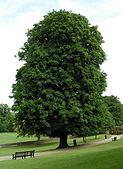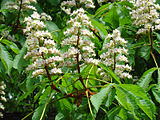
Native to the Balkans, this deciduous tree is a member of the soapberry family, Sapindaceae, that also includes maple, lychee, and buckeye. It has a deep taproot and grows up to 75′ tall with a spread up to 65′. The palmate compound leaves are 24″ across and have 5-7 ovate to oblong leaflets that are 4-10″ long. They are light green in spring, mature to dark green in summer, and turn an uninteresting yellow to brown in the fall. In spring, terminal panicles appear that are 4-12″ long and composed of 20-50 flowers. The flowers are white with a yellow throat speckled with red. One to five flowers per panicle give rise to a globular fruit that consists of 1-2 seeds (horse chestnuts) in a leathery, brown husk that is 1-3″ long and spiny. The seeds are shiny, dark brown and bear a pale round scar at the base. They are poisonous, unlike chestnuts that are produced by an unrelated tree, (Castanea) belonging to a different plant family. European horse chestnuts can be beautiful park or street trees if their foliage does not deteriorate during the summer. The genus name, Aesculus, is the Latin word for a species of oak with edible nuts, so is a misnomer for this plant. The specific epithet, hippocastanum, is from the Greek word hippos meaning horse and the Latin word castanea meaning the chestnut tree of Virgil.

Type: Deciduous tree
Outstanding Feature: Flowers, shade
Form: Pyramidal with oval to rounded crown
Growth Rate: Medium to rapid
Bloom: Panicles of white flowers with yellow throats speckled with red in spring
Size: 50-75′ H x 40-65′ W
Light: Full sun to partial shade
Soil: Average, medium moist, well-drained
Hardiness: Zones 3-8
Care: Protect from wind and drought
Pests and Diseases: Bagworms, Japanese beetles, leaf miner, scale; anthracnose, bleeding canker, Guignardia leaf blotch, powdery mildew
Propagation: Fresh seed (short viability)
Outstanding Selections:
‘Baumennii’
‘Wisselink’
Photo Credits: Wikipedia